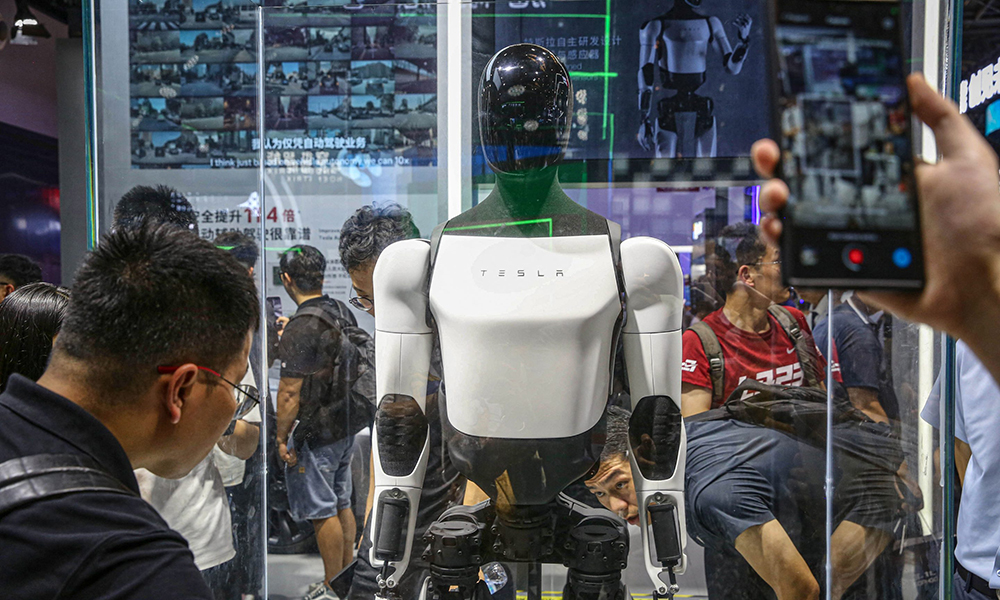
特斯拉正在采取下一步举措开发人形机器人擎天柱——或者说,至少它正在雇佣员工来执行上述步骤。时薪最高可达48美元,你可以帮助收集数据,训练特斯拉的人工智能机器人,使公司工厂的工作实现自动化。
根据领英(LinkedIn)、Indeed和特斯拉网站上的招聘信息,埃隆·马斯克(Elon Musk)旗下的电动汽车公司正在招聘“数据收集操作员”来收集运动信息,并为擎天柱机器人提供设备反馈。工作人员需要穿上动作捕捉服,戴上虚拟现实头戴式显示器来模拟机器人的动作和行动。根据招聘要求,应聘者必须每天行走7小时以上,身高在5英尺7英寸(约合1.7米)到5英尺11英寸(约合1.8米)之间,以便操作动作捕捉服。报酬在每小时25.25美元到48美元之间。
在今年5月特斯拉社交媒体上分享的一段视频中,数十名远程操作人员戴着动作捕捉和虚拟现实设备,站在擎天柱机器人旁边。在一个宽敞的白色房间里,员工们站在一块黑色的垫子上,缓慢而机械地模仿抬起和放置物品的动作,而擎天柱机器人也在完成同样的动作,只不过它们面前摆放的是真实的物品。在同一个空间里,机器人在没有人类员工陪同的情况下练习行走和完成其他任务,比如叠衣服。
特斯拉于2021年宣布了擎天柱项目,目标是用它来完成工厂中“不安全、重复或枯燥”的任务。在疫情时期劳动力短缺的刺激下,这一举措与全行业加大了对自动化的投资相一致。据Westernacher Consulting的数据,截至2016年,10%的仓库报告使用了意义重大的自动化技术,而根据麦肯锡(McKinsey)的数据,到2030年,机器人出货量预计将以每年至高50%的速度增长。
但特斯拉的自动化努力尚未取得成果。与马斯克的其他雄心一样,擎天柱的时间表也是承诺过多,却未能兑现。2022年,马斯克表示,擎天柱最早可能在2023年开始生产。机器人专家最初对擎天柱感到失望,他们在看过2022年的Bumble C机器原型后,发现它在很大程度上不尽如人意。
美国电气与电子工程师协会会刊《IEEE Spectrum》的机器人编辑埃文·阿克曼(Evan Ackerman)在为该杂志撰写的文章中写道:“虽然马斯克在台上短暂展示的人形机器人没有任何问题,但也没有任何独特之处。我们对特斯拉抱有更高的期望(即使不一定会实现)。”
从那时起,擎天柱项目取得了长足的进步。根据特斯拉2024年第二季度财报,该机器人最近的一次迭代首次在特斯拉的一家工厂完成了处理电池的自主任务。马斯克在7月份表示,这些机器人最早将于明年投入生产,供内部使用,目标是在2026年出售给其他公司。特斯拉没有回应《财富》杂志的置评请求。
对“擎天柱”的乐观态度
这位特斯拉首席执行官一直看好擎天柱对特斯拉运营的影响,相信这款机器人可以推动这家电动汽车公司的估值达到25万亿美元。这是其目前估值6929.4亿美元的36倍多,是苹果公司(Apple)3.41万亿美元市值的7倍多。马斯克预计最终产量将超过200亿,他认为,随着工业需求的不断增长,全球80亿人将需要这款产品。
但任务自动化机器人的竞争正在升温。今年2月,另一家人工智能机器人公司Figure宣布在最新一轮融资中获得6.75亿美元,估值达到26亿美元。今年年初,该公司在OpenAI的创业基金、微软(Microsoft)、英伟达(Nvidia)和杰夫·贝索斯(Jeff Bezos)的Bezos Expeditions的支持下,与宝马(BMW)达成了一项商业协议,协助这家汽车制造商进行汽车制造。在确定了这项技术的最佳用途后,Figure和宝马将在该公司位于南卡罗来纳州斯帕坦堡的工厂使用这些机器人。
如果特斯拉想要与竞争对手一决高下,它还得费一番功夫。佐治亚理工学院(Georgia Institute of Technology)机器人教授、英伟达研究院(Nvidia Research)高级研究员阿尼米什·加格(Animesh Garg)表示,擎天柱机器人将需要不断更新和制作新原型。机器人的每一个组件和升级都是量身定制的,而员工为收集机器人运行数据所进行的早期研究是一项巨大的投资,还会带来风险。
加格告诉科技网站“商业内幕”(Business Insider):“大规模生产机器人是极其困难的。你需要的数据收集量动辄就会耗费5亿美元,而真正的问题是‘即使你做到了,你能取得成功吗?’难题在于无法保证成功。”(财富中文网)
译者:中慧言-王芳
特斯拉正在采取下一步举措开发人形机器人擎天柱——或者说,至少它正在雇佣员工来执行上述步骤。时薪最高可达48美元,你可以帮助收集数据,训练特斯拉的人工智能机器人,使公司工厂的工作实现自动化。
根据领英(LinkedIn)、Indeed和特斯拉网站上的招聘信息,埃隆·马斯克(Elon Musk)旗下的电动汽车公司正在招聘“数据收集操作员”来收集运动信息,并为擎天柱机器人提供设备反馈。工作人员需要穿上动作捕捉服,戴上虚拟现实头戴式显示器来模拟机器人的动作和行动。根据招聘要求,应聘者必须每天行走7小时以上,身高在5英尺7英寸(约合1.7米)到5英尺11英寸(约合1.8米)之间,以便操作动作捕捉服。报酬在每小时25.25美元到48美元之间。
在今年5月特斯拉社交媒体上分享的一段视频中,数十名远程操作人员戴着动作捕捉和虚拟现实设备,站在擎天柱机器人旁边。在一个宽敞的白色房间里,员工们站在一块黑色的垫子上,缓慢而机械地模仿抬起和放置物品的动作,而擎天柱机器人也在完成同样的动作,只不过它们面前摆放的是真实的物品。在同一个空间里,机器人在没有人类员工陪同的情况下练习行走和完成其他任务,比如叠衣服。
特斯拉于2021年宣布了擎天柱项目,目标是用它来完成工厂中“不安全、重复或枯燥”的任务。在疫情时期劳动力短缺的刺激下,这一举措与全行业加大了对自动化的投资相一致。据Westernacher Consulting的数据,截至2016年,10%的仓库报告使用了意义重大的自动化技术,而根据麦肯锡(McKinsey)的数据,到2030年,机器人出货量预计将以每年至高50%的速度增长。
但特斯拉的自动化努力尚未取得成果。与马斯克的其他雄心一样,擎天柱的时间表也是承诺过多,却未能兑现。2022年,马斯克表示,擎天柱最早可能在2023年开始生产。机器人专家最初对擎天柱感到失望,他们在看过2022年的Bumble C机器原型后,发现它在很大程度上不尽如人意。
美国电气与电子工程师协会会刊《IEEE Spectrum》的机器人编辑埃文·阿克曼(Evan Ackerman)在为该杂志撰写的文章中写道:“虽然马斯克在台上短暂展示的人形机器人没有任何问题,但也没有任何独特之处。我们对特斯拉抱有更高的期望(即使不一定会实现)。”
从那时起,擎天柱项目取得了长足的进步。根据特斯拉2024年第二季度财报,该机器人最近的一次迭代首次在特斯拉的一家工厂完成了处理电池的自主任务。马斯克在7月份表示,这些机器人最早将于明年投入生产,供内部使用,目标是在2026年出售给其他公司。特斯拉没有回应《财富》杂志的置评请求。
对“擎天柱”的乐观态度
这位特斯拉首席执行官一直看好擎天柱对特斯拉运营的影响,相信这款机器人可以推动这家电动汽车公司的估值达到25万亿美元。这是其目前估值6929.4亿美元的36倍多,是苹果公司(Apple)3.41万亿美元市值的7倍多。马斯克预计最终产量将超过200亿,他认为,随着工业需求的不断增长,全球80亿人将需要这款产品。
但任务自动化机器人的竞争正在升温。今年2月,另一家人工智能机器人公司Figure宣布在最新一轮融资中获得6.75亿美元,估值达到26亿美元。今年年初,该公司在OpenAI的创业基金、微软(Microsoft)、英伟达(Nvidia)和杰夫·贝索斯(Jeff Bezos)的Bezos Expeditions的支持下,与宝马(BMW)达成了一项商业协议,协助这家汽车制造商进行汽车制造。在确定了这项技术的最佳用途后,Figure和宝马将在该公司位于南卡罗来纳州斯帕坦堡的工厂使用这些机器人。
如果特斯拉想要与竞争对手一决高下,它还得费一番功夫。佐治亚理工学院(Georgia Institute of Technology)机器人教授、英伟达研究院(Nvidia Research)高级研究员阿尼米什·加格(Animesh Garg)表示,擎天柱机器人将需要不断更新和制作新原型。机器人的每一个组件和升级都是量身定制的,而员工为收集机器人运行数据所进行的早期研究是一项巨大的投资,还会带来风险。
加格告诉科技网站“商业内幕”(Business Insider):“大规模生产机器人是极其困难的。你需要的数据收集量动辄就会耗费5亿美元,而真正的问题是‘即使你做到了,你能取得成功吗?’难题在于无法保证成功。”(财富中文网)
译者:中慧言-王芳
Tesla is taking the next steps in developing its humanoid Optimus robots—or at least it’s hiring workers to take those literal steps. For up to $48 an hour, you could help collect data to train Tesla’s AI-powered robots, designed to automate work in company factories.
According to job listings on LinkedIn, Indeed, and Tesla’s website, Elon Musk’s electric vehicle company is hiring “data collection operators” to gather movement information and provide equipment feedback on the Optimus robots. Workers are required to wear motion-capture suits and virtual reality headsets to simulate the movements and actions of the bots. Per the job listing, applicants must be able to walk for over seven hours a day and should be between 5’7″ and 5’11″ in order to operate the motion-capture suits. Payment ranges between $25.25 and $48 per hour.
In a video shared across Tesla’s social media in May, dozens of teleoperations workers wear motion-capture and VR equipment and stand alongside the Optimus bots. Standing on a black mat in a large white room, workers mimic lifting and placing items slowly and mechanically, while Optimus bots complete that same motion, but with real items in front of them. In the same space, the robots practice walking and completing other tasks like folding laundry, unaccompanied by human workers.
Tesla announced its Optimus project in 2021, with the goal of using it to complete factory tasks that were “unsafe, repetitive or boring.” The initiative aligns with greater industry-wide investment in automation, spurred by pandemic-era labor shortages. As of 2016, 10% of warehouses reported using meaningful automation technology, according to Westernacher Consulting, with robot shipments expected to increase by up to 50% each year until 2030, per McKinsey data.
But Tesla’s automation efforts have not yet come to fruition. Like Musk’s other ambitions, Optimus’s timeline has overpromised and under-delivered. In 2022, Musk suggested Optimus production could begin as early as 2023. Optimus was initially met with disappointment from roboticists, who, after seeing the 2022 Bumble C prototype of the machine, found it largely underwhelming.
“While there’s absolutely nothing wrong with the humanoid robot that Musk very briefly demonstrated on stage, there’s nothing uniquely right, either,” Evan Ackerman, robotics editor for technology magazine IEEE Spectrum, wrote for the publication. “We were hoping for (if not necessarily expecting) more from Tesla.”
Since then, the Optimus project has made strides.The most recent iteration of the robot saw it perform its first autonomous task of handling batteries at one of Tesla’s facilities, according to its 2024 second-quarter earnings. Musk said in July the robots will be in production for internal use as early as next year, with the goal of being sold to other companies in 2026. Tesla did not respond to Fortune’s request for comment.
Optimus optimism
The Tesla CEO has been bullish on the impact of Optimus on Tesla’s operations, confident the robots could drive the EV company to a $25 trillion valuation. That’s over 36 times its current valuation of $692.94 billion, and over seven times that of Apple’s $3.41 trillion market cap. Musk estimated the eventual production of over 20 billion units, arguing the planet’s 8 billion people will want the product, alongside the growing industrial demand.
But competition for task-automating robots is heating up. In February, Figure, another AI-powered robotics firm, announced $675 million in its latest funding round, giving it a valuation of $2.6 billion. At the beginning of the year, the company—backed by OpenAI’s start-up fund, Microsoft, Nvidia, and Jeff Bezos’s Bezos Expeditions—minted a commercial agreement with BMW to assist the carmaker in vehicle manufacturing. After identifying the best uses for the technology, Figure and BMW will implement the bots at the auto company’s Spartanburg, South Carolina, factory.
If Tesla wants to put up a fight against competing AI robotics companies, it has its work cut out for it. Optimus robots will require constant updates and new prototypes, argued Animesh Garg, robotics professor at Georgia Institute of Technology and senior researcher at Nvidia Research. Each component and upgrade is custom to the bots, and early research in the worker-powered efforts of gathering data on its functioning is a steep investment—and risk.
“It [is] extremely difficult to produce robots at scale,” Garg told Business Insider. “The amount of data collection you’d need would easily be half a billion dollars, and the real question is ‘Even if you do that, do you succeed?’ Because there is no guarantee of success.”






